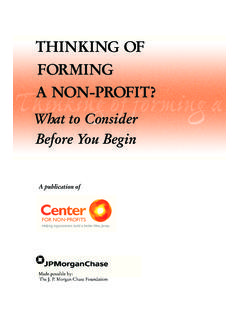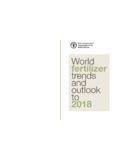Transcription of NEW JERSEY NON PROFITS
1 NEW JERSEY NON- PROFITS 2018 trends and outlook April 2018 A publication of Generously supported by 1 New JERSEY Non- PROFITS 2018 trends and outlook Executive Summary This report is the latest in a series of annual surveys designed to gauge trends , experiences and expectations among New JERSEY non-profit organizations, and to explore the effects of the economy on New JERSEY s charitable community. The Center for Non- PROFITS conducted this year s survey online in January 2018 to assess how non- PROFITS fared in 2017 and to determine their outlook for the coming year. This analysis is based on the 252 responses from 501(c)(3) organizations submitted during the survey period.
2 The survey responses reveal the strength and importance of the work of non- PROFITS , as well as the stressors and vulnerabilities stemming from prolonged resource deprivation and a volatile economic and policy landscape. Among the key findings: Continuing, Rising Demand for Services: An overwhelming majority (71%) of responding organizations reported that demand for services had increased during the past year, and more than three-quarters (77%) expected demand to continue rising in 2018. Funding Gap: o Two-fifths (42%) reported receiving more total funding in 2017 vs. 2016, but more than half (56%) reported that their expenses were higher than in the previous year.
3 O Only 28% indicated that support and revenue had exceeded expenses during their most recently completed fiscal year. o Nearly two-thirds (64%) expected their total expenses to increase in 2018, but only 48% expected total 2018 funding to increase. About one-third (30%) expected total funding to remain the same as 2017, and 13% anticipated a decrease. Regarding specific types of funding, respondents were most optimistic about donations from individuals and most uncertain about funding from government. Respondents were more likely to predict flat funding than either increases or decreases in most funding categories. Actions Taken: Organizations continued to seek additional resources such as funding and volunteers to support their work, whether through new fundraising appeals, pursuing funding from alternative sources, or recruiting volunteers.
4 Half reported that they were considering new partnerships or collaborations in 2018, close to 45% were contemplating adding a special event or new programs, and nearly one-third (30%) planned to conduct more advocacy for their programs, fields or constituencies. At the same time, responses also seemed to express the uncertainty regarding the current economic and funding environment. For example, 34% said that they might add staff in 2018, but only 13% definitely planned to, and only 4% had already done so when the survey was taken. One quarter indicated that they might raise salaries, while 20% said that they might freeze or cut salaries.
5 Partnerships and Collaborations: Consistent with previous surveys, nearly half of respondents (47%) reported launching new partnerships or collaborations, most commonly with other non-profit organizations, although partnerships with government and business were also reported. Fifteen percent said that they might, or definitely would, explore a merger in 2018 and 7% said that they definitely would or might complete one. Challenges Faced by Individual Organizations: Asked to identify the issues presenting the greatest challenges to the viability of their own organizations, non- PROFITS most frequently mentioned: o the need for better branding or communications (53%) o financial uncertainty (51%) o the need for a stronger board (45%) o increased benefits/ insurance costs (36%) o inability to afford enough good staff (31%) 2 o increased demand for program services (28%) o the need to increase advocacy/public policy (28%) Non-Profit Sector Issues.
6 Similar to prior years, issues related to infrastructure, governance and funding again dominated the concerns about the non-profit community overall. Regarding the issues most important to maintaining and improving the viability of the non-profit sector in the coming decade, non- PROFITS most frequently selected: o non-profit infrastructure/capacity building (51%) o foundation/corporate funding (46%) o attracting/retaining capable, committed board members (46%) o state fiscal policy/budget (33%) o giving and volunteering incentives (32%) o federal funding/federal budget (31%) o non-profit advocacy/lobbying rights (30%) o diversity/inclusion/equity within non- PROFITS (28%) Overall outlook .
7 Roughly half (53%) of non- PROFITS indicated that their overall circumstances had improved over the past year, a slight improvement over our past two surveys but notably less than 2015. Their outlook for the coming year was markedly less positive than one year ago. Forty-four percent expected their organization s circumstances to improve in the coming year (down from 53% last year), while 9% predicted that it would worsen, and 35% said they did not know or it was too early to tell. Implications This year s survey reflects the continued challenges and opportunities confronting New JERSEY s non- PROFITS while it also underscores their persistence, resilience and creativity.
8 Prolonged economic uncertainty, exacerbated this year by questions about the impact of the new federal tax law on charitable giving, on non- PROFITS , and on New Jerseyans generally, have prompted many organizations to redouble their efforts to expand and strengthen relationships with donors and institutional funders while also exploring opportunities for new collaborations and program adjustments. At the same time, the volatility of the public policy and economic landscape and a new gubernatorial administration in Trenton have prompted many to ramp up their advocacy and civic engagement activities. The overarching, recurring finding is the clear and persistent gap between rising demand for non- PROFITS programs and lagging resources a pattern which has now extended for a decade or more.
9 This resource gap threatens to compromise the provision of vital programs and services in communities and hampers the ability of non- PROFITS to attract and retain the talented leaders and professionals needed at all levels to fulfill their public missions. Given the indispensable role they play in the social and economic well-being of the state and its residents, ensuring that New JERSEY s non- PROFITS are equipped to meet our communities needs must be a top priority. Strategic investments, stakeholder partnerships, communications and advocacy will continue to be essential over the short and long term. The Center for Non- PROFITS will continue to gather and share information about economic, social and policy trends and will work cooperatively to advance solutions.
10 3 Background and Methodology The New JERSEY Non-Profit Issues and trends Survey is conducted annually by the Center for Non- PROFITS in order to gauge trends , experiences and views of our state s non-profit community. The Center conducted this year s survey online in January 2018 to assess how non- PROFITS fared in 2017 and to determine their outlook for the coming year. An email announcement with a link to the survey was sent to approximately 4,800 subscribers of the Center s email list, and additional outreach was made via social media (Facebook, Twitter and LinkedIn), non-profit listservs and to funders or other umbrella organizations serving non- PROFITS in the state.







